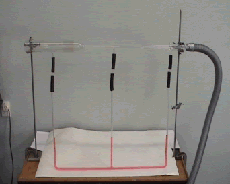Abstract
 The height of the fluids in the tubes indicates that pressure is highest where the fluid is moving fastest.
The height of the fluids in the tubes indicates that pressure is highest where the fluid is moving fastest.
The photo at right shows the Bernoulli Tubes apparatus. The red liquid is pushed down further when the pressure is higher. Download video below.
Portable
Yes
Principles Illustrated
Bernoulli Principle. See additional notes below.
Video
Download video (right-click and “save link as”): Bernoulli Tubes.m4v
Powerpoint
Powerpoint for use with this demonstration (right-click and “save link as”): Fluid_Demos.ppt
NCEA & Science Curriculum
Extension
Instructions
We have two versions. A large version for lecture theaters that operates on air, and a smaller version for classrooms and labs that can operate with either air or water.
The air flow has to be adjusted and it helps to put fairly long hoses on each end of the apparatus.
Safety
The larger version is somewhat delicate as it has not been annealed. Handle with more than usual care.
Individual teachers are responsible for safety in their own classes. Even familiar demonstrations should be practised and safety-checked by individual teachers before they are used in a classroom.
Notes
Bernoulli’s principle tells us that the pressure is lowest in a fluid where the fluid is moving fastest (for points at the same height). This is reflected in Bernoulli’s equation for an incompressible fluid.![]()
Where the fluid is moving fastest, in the smallest diameter tube, the pressure should be lowest.
The Bernoulli equation is exact only under restricted conditions and will apply only approximately to air flow in these experiments. However, the observed pressures are in the correct order: largest in the large diameter tube and smallest in the small diameter tube.
Related Resources
- Bernoulli plates
- Floating Ball
- Funnel Ball
Teaching Resources
Would you like to contribute lesson suggestions? Contact us.
References
PIRA 2C20.10
Credits
This teaching resource was developed with support from
The MacDiarmid Institute
Faculty of Science, Victoria University of Wellington
School of Chemical and Physical Sciences, Victoria University of Wellington